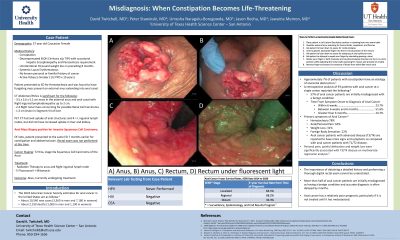Sunday Poster Session
Category: Colorectal Cancer Prevention
P0455 - Misdiagnosis: When Constipation Becomes Life-Threatening
Sunday, October 27, 2024
3:30 PM - 7:00 PM ET
Location: Exhibit Hall E

Has Audio

David K. Twitchell, MD
University of Texas Health Science Center
San Antonio, TX
Presenting Author(s)
David K.. Twitchell, MD1, Peter Stawinski, MD1, Umesha Naragalu, MD2, Jason Rocha, MD1, Jawairia Memon, MD1
1University of Texas Health Science Center, San Antonio, TX; 2University of Texas Health San Antonio, San Antonio, TX
Introduction: Anal cancer is newly diagnosed in over 10,000 Americans each year. Signs and symptoms of anal cancer can vary for each patient but likely include some combination of hematochezia, anal/perianal pain, weight loss, constipation, and foreign body sensation.
Case Description/Methods: A 57-year-old Caucasian Female with a history of constipation and Alcoholic Cirrhosis status post Transjugular Intrahepatic Portosystemic Shunt (TIPS) with occasional hepatic encephalopathy and paracentesis requirement presented to our hospital for acute hematochezia and a reported 70 lb unintentional weight loss over the past 8 months. Physical exam in the Emergency Department revealed a large fungating mass of the external anus with anal canal involvement. CT imaging confirmed a 3.5x3.6x5.2 cm external anal mass with concomitant Right inguinal lymphadenopathy. Biopsy samples were taken and indicated the patient was positive for T2 N1a, Stage IIIa invasive Squamous Cell Carcinoma of the Anus. Of note, the patient was seen in the same ED 7 months prior for constipation and abdominal pain. A rectal exam was not performed at that time and the patient was discharged from the ED with a simple bowel regimen. The patient did not seek further medical care in the interval of the two ED visits. She is currently alive at 8-month follow-up and is undergoing both chemotherapy and radiation therapy for treatment of her anal cancer.
Discussion: This case highlights the importance of obtaining a thorough clinical history and performing a rectal exam when clinically indicated. Studies indicate that ~7% of constipation stems from an anorectal obstructive etiology and up to 57% of anal cancer patients are initially misdiagnosed as having a benign condition. As 5-year survival rates of anal cancer with distant spread are only 36.3% compared to 85.5% of localized spread per the SEER database, a misdiagnosis of anal cancer due to limited history taking and physical exam of the clinician can significantly impact the mortality rate by delaying diagnosis and time to treatment.
Disclosures:
David K.. Twitchell, MD1, Peter Stawinski, MD1, Umesha Naragalu, MD2, Jason Rocha, MD1, Jawairia Memon, MD1. P0455 - Misdiagnosis: When Constipation Becomes Life-Threatening, ACG 2024 Annual Scientific Meeting Abstracts. Philadelphia, PA: American College of Gastroenterology.
1University of Texas Health Science Center, San Antonio, TX; 2University of Texas Health San Antonio, San Antonio, TX
Introduction: Anal cancer is newly diagnosed in over 10,000 Americans each year. Signs and symptoms of anal cancer can vary for each patient but likely include some combination of hematochezia, anal/perianal pain, weight loss, constipation, and foreign body sensation.
Case Description/Methods: A 57-year-old Caucasian Female with a history of constipation and Alcoholic Cirrhosis status post Transjugular Intrahepatic Portosystemic Shunt (TIPS) with occasional hepatic encephalopathy and paracentesis requirement presented to our hospital for acute hematochezia and a reported 70 lb unintentional weight loss over the past 8 months. Physical exam in the Emergency Department revealed a large fungating mass of the external anus with anal canal involvement. CT imaging confirmed a 3.5x3.6x5.2 cm external anal mass with concomitant Right inguinal lymphadenopathy. Biopsy samples were taken and indicated the patient was positive for T2 N1a, Stage IIIa invasive Squamous Cell Carcinoma of the Anus. Of note, the patient was seen in the same ED 7 months prior for constipation and abdominal pain. A rectal exam was not performed at that time and the patient was discharged from the ED with a simple bowel regimen. The patient did not seek further medical care in the interval of the two ED visits. She is currently alive at 8-month follow-up and is undergoing both chemotherapy and radiation therapy for treatment of her anal cancer.
Discussion: This case highlights the importance of obtaining a thorough clinical history and performing a rectal exam when clinically indicated. Studies indicate that ~7% of constipation stems from an anorectal obstructive etiology and up to 57% of anal cancer patients are initially misdiagnosed as having a benign condition. As 5-year survival rates of anal cancer with distant spread are only 36.3% compared to 85.5% of localized spread per the SEER database, a misdiagnosis of anal cancer due to limited history taking and physical exam of the clinician can significantly impact the mortality rate by delaying diagnosis and time to treatment.
Disclosures:
David Twitchell indicated no relevant financial relationships.
Peter Stawinski indicated no relevant financial relationships.
Umesha Naragalu indicated no relevant financial relationships.
Jason Rocha indicated no relevant financial relationships.
Jawairia Memon indicated no relevant financial relationships.
David K.. Twitchell, MD1, Peter Stawinski, MD1, Umesha Naragalu, MD2, Jason Rocha, MD1, Jawairia Memon, MD1. P0455 - Misdiagnosis: When Constipation Becomes Life-Threatening, ACG 2024 Annual Scientific Meeting Abstracts. Philadelphia, PA: American College of Gastroenterology.
